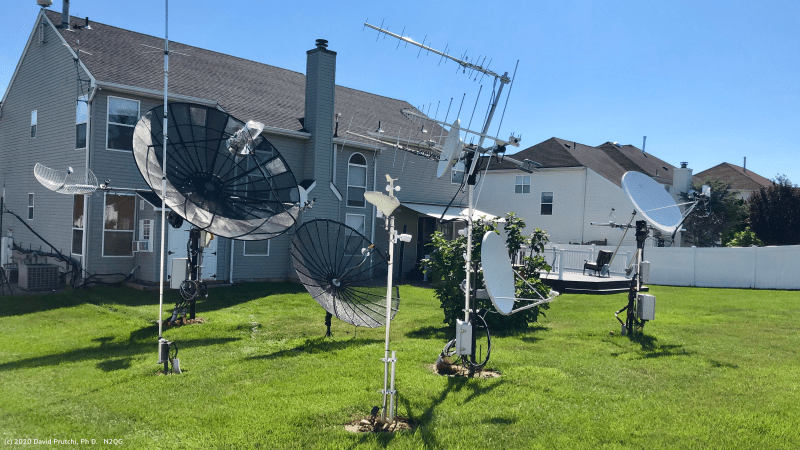Ham radio operators love to push the boundaries of their equipment. A new ham may start out by making a local contact three miles away on the 2m band, then talk to somebody a few hundred miles away on 20m. Before long, they may find themselves chatting to fellow operators 12,000 miles away on 160m. Some of the adventurous return to 2m and try to carry out long-distance conversations by bouncing signals off of the Moon, waiting for the signal to travel 480,000 miles before returning to Earth. And then some take it several steps further when they listen to signals from spacecraft 9.4 million miles away.
That’s exactly what [David Prutchi] set out to do when he started building a system to listen to the Deep Space Network (DSN) last year. The DSN is NASA’s worldwide antenna system, designed to relay signals to and from spacecraft that have strayed far from home. The system communicates with tons of inanimate explorers Earth has sent out over the years, including Voyager 1 & 2, Juno, and the Mars Reconnaissance Orbiter. Because the craft are transmitting weak signals over a great distance (Voyager 1 is 14 billion miles away!), the earth-based antennas need to be big. Real big. Each of the DSN’s three international facilities houses several massive dishes designed to capture these whispers from beyond the atmosphere — and yet, [David] was able to receive signals in his back yard.
Sporting a stunning X-band antenna array, a whole bunch of feedlines, and some tracking software, he’s managed to eavesdrop on a handful of spacecraft phoning home via the DSN. He heard the first, Bepi-Colombo, in May 2020, and has only improved his system since then. Next up, he hopes to find Juno, and decode the signals he receives to actually look at the data that’s being sent back from space.
We’ve seen a small group of enthusiasts listen in on the DSN before, but [David]’s excellent documentation should provide a fantastic starting point for anybody else interested in doing some interstellar snooping.
















The Link https://www.prutchi.com/2020/10/15/recap-of-x-band-dsn-activities-and-plans-for-the-future/
gets the ole 404!
Hmm… it works for me still (just checked on my phone to avoid caching too)
My Firefox, says “Caution, Dangerous Site Ahead.
I’m still working with my hosting provider to allow me to use an external (free) certificate, so I’m not on https yet. Nevertheless, prutchi.com is safe.
Looks like the site is using a self-signed SSl Certificate, hence the privacy warning.
Yeah, self-signed or expired (or both) certificate. If i accept the “risk” (there is none here) it redirects to a 404 on another site, some therapy-stuff.
My wife is a psychotherapist… which may explain a lot of things :) Try it without having your website force https, just plain http
or outdated os on the client side
The link in the article is http, and is working for me, the link in the comment https…
For the later I am getting a “MOZILLA_PKIX_ERROR_SELF_SIGNED_CERT” error and the notice that the cert expired on 2020-04-06.
The link in the article has no https, so that’s also why browsers throw warnings, there is no valid certificate because there actually is no https.
http://www.prutchi.com/2020/10/15/recap-of-x-band-dsn-activities-and-plans-for-the-future/ NOT http S
I wouldn’t say those spacecraft have “strayed” from home. We sent them where they are, and navigate them on a more-or-less continuous basis.
In any case, someone interested in detecting downlink signals should check out the Amateur-DSN group https://groups.io/g/Amateur-DSN/. There’s half a dozen or so folks who are regularly reporting hearing one or another spacecraft, and a whole bunch who contribute.
These days, with microwave parts getting cheap, the X-band LNA and downconverter you need at 8.4 GHz is easier than ever to build.
Agree with Jim. I neglected to mention https://groups.io/g/Amateur-DSN/ as a wonderful resource for beginner and advanced experimenters. I’ll make sure to add a “resources” section when I update the paper with great feedback that I’m receiving from the Amateur DSN community.
This guy is either not married, or has the most understanding wife ever.
Happily for me, it’s the latter :)
Lets hope its the second ^^
And a bucket load of cash and free time to go with it. Its certainly very impressive.
You would be surprised how many husband/wife hams there are. I now of at least 3 teams.
A good accomplishment. I remember reading about an amateur picking up the carrier on Voyager 1 back in the 1980s with backyard dish and an Atari 800.
I’m still waiting for a plucky amateur to decode engineering data, not just pick up the carrier. Then the next step — command and control of something like Pioneer 6 (abandoned, but apparently still operational in solar orbit).
Wouldn’t that require a rather powerful (illegal) transmitter?
Demodulating and decoding telemetry is possible. Please see Dr Daniel Estevez’ GNUradio workshop exactly on this: https://youtu.be/RDbs6l4rMhs. “Taking control” would be a completely different matter, both from the technical and legal perspectives
Amateurs did gain control of ICE (formerly ISEE-3) when it came close to Earth (around 2018 as I recall) but were unable to put it back into halo orbit because the propulsion system had failed.
Adam Zeloof, as in, the brother of Sam Zeloof?
You might be surprised to find out that women are interested in science, technology, and radio also.
But why? There’s so much better things to do
For some of them, it is where they can meet the guys.